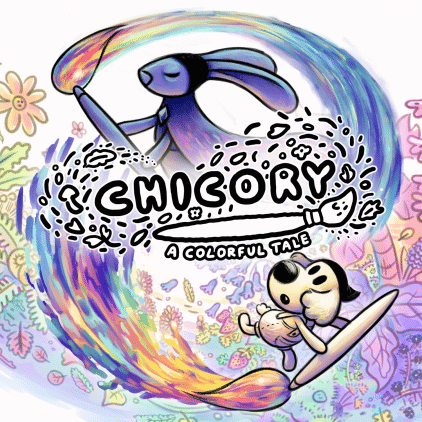Chicory: A Colorful Tale intrigued me further and further every time I saw it pop up in some format. There’s just something about a cute dog splashing paint on a colorless world that left me wanting more. Then my interest peaked when I found out that both Greg Lobanov and Lena Raine are part of the small team making the game. As someone that loved both Wandersong and Celeste for a myriad of reasons, Chicory suddenly became a game I had to check out. Once I found out that we would have the opportunity to review Chicory: A Colorful Tale, I took on the task without looking up anything else about the game.
After finishing Chicory and spending many hours exploring and bringing back the world to a semblance of its former glory, I can say that Chicory: A Colorful Tale is full of surprises and certainly has some great moments not only in its gameplay but in its story as well. But perhaps what stood out for me the most, though, is how all of its aspects charmed me into enjoying a Zelda game for the first time ever.
Game Name: Chicory: A Colorful Tale
Platform(s): PlayStation 5, PlayStation 4, PC
Publisher(s): Finji
Developer(s): Greg Lobanov, Lena Raine, Alexis Dean-Jones, Madeline Berger, Em Halberstadt
Release Date: June 10, 2021
Price: 19.99
Coloring in the World of Picnic in Chicory: A Colorful Tale
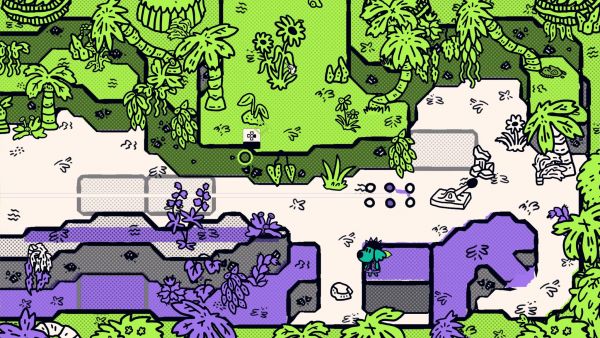
Chicory: A Colorful Tale is, in essence, a tile-based game similar to the 2D Legend of Zelda titles. However, instead of playing as a young boy named Link, you are a genderless puppy dog who bears the name of your favorite edible item. So, for example, my dog is named Ice Cream. Your canine protagonist is actually the janitor for the current Wielder named Chicory. Wielders have the important task of sustaining the colors in each area of the world of Picnic. One day, as you head out to do your daily tasks, you discover that the world has lost its color and Chicory has disappeared as well. Luckily the tool that actually gives wielders their power, the Brush, is somehow untouched and suddenly without an owner. Naturally, as Chicory’s biggest fan, your pooch does what anyone would do and picks up the brush with hopes of finding its source of inspiration. However, fate has other plans, and you become the defacto wielder who now bears the weight of an entire populace on your tiny shoulders.
This burden is felt almost immediately as concerned townsfolk wonder what happened to the color in their area or their homes. Proceeding through each screen gives you a quick glimpse of why a wielder is important, and as your fellow food named animal dwellers begin to accept their new reality, it doesn’t take long for a few of them to start making requests that you paint their abodes or make them a new T-Shirt logo. This also neatly introduces Chicory: A Colorful Tale‘s main gameplay element, painting, painting, and some drawing to boot. I mean, what else are you supposed to do with a brush anyway? Thankfully though, you are never forced to create masterpieces. You only have to paint what is absolutely necessary. Sure, there are moments where precision or exactness may be required, but mostly, painting is optional. This idea carries through the entire game and is one of the prime reasons Chicory: A Colorful Tale stuck with me because so much of it is completely left up to you. Thus allowing gamers that just want to “beat the game” the opportunity to do so. However, those that choose to unturn its proverbial stones will miss out on many of the game’s delightful aspects. One of these aspects is, in fact, the painting.
When Picnic loses its hue, as the wielder in this black and white coloring book world, it’s now your main task to figure out why it happened. Along the way, each town or a certain area will have its own set of four colors and three brush sizes that you can freely choose from. This helps give you ideas without ever becoming overwhelming. At the same time, it also encourages creativity with those same elements as well. At first, attempting to fulfill a request seems daunting; as someone that is not an art person, I used the smallest paint style and made sure I stayed between the lines, or if they asked for a distinct color type, I tried to use what I thought matched. It wasn’t until my pup was asked to make a logo for something, especially considering I wasn’t going to be drawing anything aside from stick figures, it suddenly clicked for me. Seeing the bar owner be as jubilant for my logo as if I’d drawn the next great showpiece was exhilarating. It encouraged me to want to continue to help more members of each town because they understood that my doggy was trying its best.
The Times Painting Does Matter: Puzzles
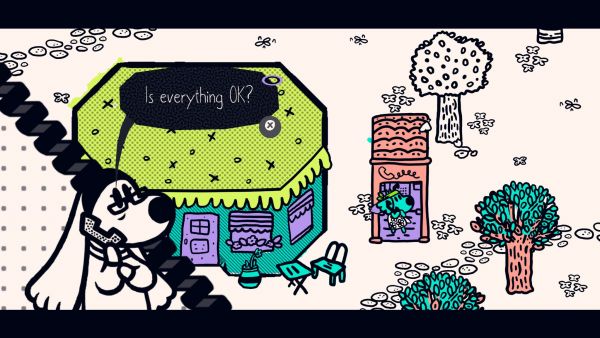
Although there is a large portion of Chicory: A Colorful Tale that is completely optional, there are several elements that are integral to completing the game. One of them is the puzzles, which test your will in different ways while also being truly one of the best parts of the game as a whole. Two of the main reasons I usually don’t find Zelda games all that appealing are one because it can be easy to get lost, and the second is that I grow tired of the puzzle mechanics after a while and wind up falling out with it. The first part is usually handled by whatever important person you are bound to meet on the journey or someone you meet in town. Giving you a direction of where to go, but sort of leaving it up to you to find it.
However, the game also has a special hint system that is done all by going to a phone booth and calling your loveable mom and dad. After giving your fellow canine mother a one-line synopsis of the events so far, she’ll give you a direct hint of “go to this town” or “I think you should go to this place next.” Suddenly, a claw appears, and your mother tells you your dad can’t help himself, “he must give you all the details.” Your Racoon father then proceeds to tell you exactly what to do next in exact detail with the correct number of screens or steps to solve a difficult puzzle. It is so silly but yet so adorable that I wanted to call home even if I knew exactly where to go, just to see what they would say next. Furthermore, phonebooths even appear in the middle of a dungeon or someplace totally unexpected. Essentially, always making sure you have a way to continue.
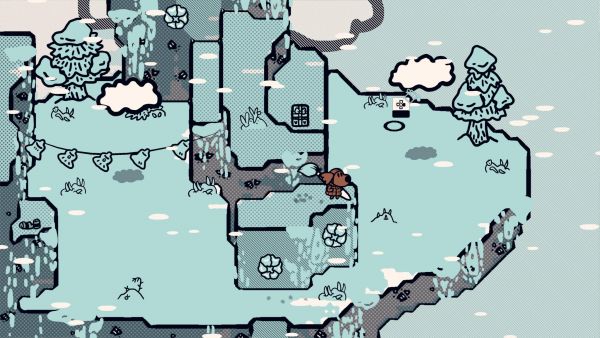
The puzzles themselves are a hallmark of Chicory: A Colorful Tale, mostly due to the sheer diversity of what’s on offer. There are the expected take-out a wall or switch puzzles along with code puzzles or secret passage puzzles that use the brush in a more direct way. Solving puzzles and finding hidden things are also used in tandem with the abilities you receive as part of continuing the story and “bonding” with the Brush. Jumping, swimming, and glowing are just some of the abilities that you’ll use to figure out what to do next. Although this isn’t to say that every single puzzle is easy to figure out. There are quite a few that really had me thinking for a bit on how to solve them, and I had to go find a guide to get through them.
However, it wasn’t like I needed to use it for an entire big section. The guide merely provided the moment of inspiration I needed, and then it gave me an understanding of the rest of the puzzles in the area. I can’t move on though, without mentioning the amazing Wielder Trials that are not only wonderful story moments but also chock full of puzzles that further expand upon the bonded abilities while also making use of platforming, the weather, the environment, or the brush to consistently present a new way to keep the adventure going. Each one is based upon a certain theme and delivers such a different experience from one to another that I found myself excited at the prospect of what each screen provided for me to discover. Going up the literal mountain while jumping into dripping clouds that are controlled by a snowstorm or venturing through a rainforest with moving leaves to find special items are not only great metaphors but also just immense amounts of fun too.
Big Fights Make a Startling Impact
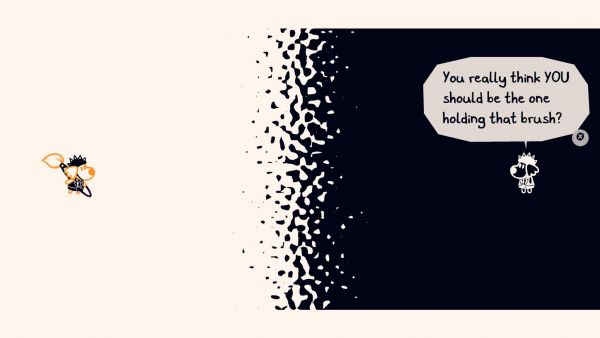
Chicory: A Colorful Tale is mostly a chill game. Focusing on painting and exploring instead of using a weapon to destroy various monsters in the overworld. However, Chicory is not totally devoid of combat encounters. Every few chapters, there are major boss battles that are not only a spectacle on the eyes and ears but also require some major coordination with the brush as well. You see, the brush is controlled freely with the right thumbstick. In the overworld, this is never an issue as you are just pointing it at a certain fixed object. Bosses move around pretty quickly, and although you don’t need to worry about actually dying, you do have to learn to dodge or find holes in attacks with the left thumbstick while attacking with the brush using the right stick.
Learning this coordination is tricky at first, but the developers did a great job of starting off slowly with big enemies that take up the entire screen to then moving towards smaller nimble confrontations. Once you figure out how to weave through this constant tussle between dodging and attacking, it lets you focus on watching the bosses’ attack patterns and deciding when best to strike with a smattering or line of paint. Boss battles also culminate the aforementioned chapters, so there are also story elements interspersed in these fights that bring an even grander feeling to them. And while yes, you cannot die or have to worry about restarting the entire fight over as you would in other games, this is not really the point. The boss battles are more of a personification of what your character or Chicory are experiencing at that moment in the story, and that is carried through each battle until the eventual finale of each scrap that brings with it an extremely satisfying feeling of victory not only in the actual win but also in vanquishing that problem for your character.

Another added element of these encounters is the amazing music done by Lena Raine. The soundtrack as a whole is awesome and includes great uplifting tunes, blissful melodies for exploration, and fantastic town themes similar to what you would get in a JRPG. However, much like with the aforementioned role-playing games, the most powerful and perhaps memorable of these are the boss battle themes. There are clear Celeste vibes in each one of them with heavy electronic and synth elements. Perhaps my favorite of them all may be the song entitled “MONSTER” that takes place in probably the best fight in the game against another former wielder. It is just this bombardment of music that matches the battle so well I can’t help but play it over and over. This is yet another masterpiece from Lena and is well worth listening to outside of the game as well.
My Goodness, So Many Feelings

Usually, in my reviews, I tend to cover the story at the beginning because I find it just as important as gameplay, but because the story of Chicory: A Colorful Tale is a heavy one, I found it better to cover some of the other elements first. That being said, while I enjoyed all of the other aspects that make up the game, the story and how it handles these major themes with such a positive grace is truly refreshing. Similar to another game from publisher Finji, Night in the Woods, the use of animal characters helps things like depression, imposter syndrome, and loneliness resonate better than had the game humans. It not only makes the tender moments so much more endearing, but those rougher parts are more malleable as well. I ran through the gambit of emotions while playing Chicory: A Colorful Tale because the story is not afraid to discuss these big topics out in the open. However, I wouldn’t quantify the game as a sob fest either.
Every moment that makes you go “damn that’s deep” or “wow, how sad” also has sweet, caring moments in the same conversation. Giving it more of this teary wholesome vibe that wants to look at the uplifting side of these scary feelings and not so much in bringing you “down in the dumps” with each one of these characters. What was even more poignant for me was how this extends to the overarching story about the brush, what it actually represents, and how each wielder has a different experience with it depending on their background before having it bestowed upon them. Chicory and your character’s journeys of being wielders are intertwined, and it is that connection that is the true heartbeat of the story. Learning more about what they each experience as wielders, the pressure, how it changes them, and how it can turn from being a passion to an overwhelming job very quickly. But it also promotes seeking help when they are feeling this way. Having your character be there for Chicory in the more downtrodden moments is not only a nice nod to the game having co-op but that she isn’t alone. The internal struggles for both Chicory and your character are also a major source of inspiration throughout the journey.
Whether it is your character wanting to understand why exactly it was chosen as a wielder to dealing with the expectations set upon wielders and why your character feels they don’t deserve the brush. All of this has a wonderful culmination in the ending of the story that made every one of these moments mean something. Tieing several story arcs into one is not easy, and it is done extremely well here. The writing for the game, in general, is top-notch, and whether you are talking to a central character or an NPC they always have something to say, and thankfully they stop talking once they are done too. The writing made me want to converse with pretty much any character I found standing around because sometimes they’d surprise me with a few funny lines or give an interesting description of the area.
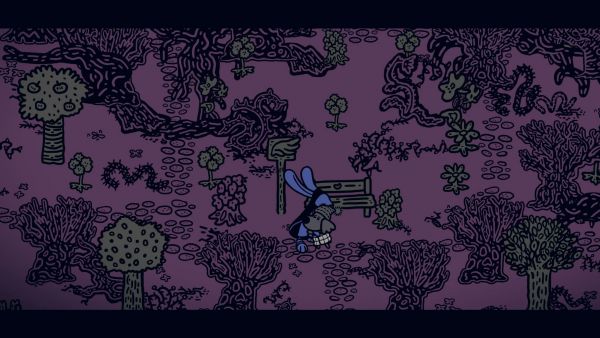
Let’s Make Some Collections
Overall there’s a lot to appreciate about Chicory: A Colorful Tale, but it is the way the team nailed the little things and gave players so much to do that sets it apart from so many other titles, both big and small. I’ve mentioned several times the world of Picnic is made like a coloring book where anything and everything can be painted. However, you are not just limited to the same colors and brush styles the entire time. Throughout the adventure, you’ll find gifts scattered all throughout the world. They may be in a dark cave that you have to light up or in a desolate area that you have to swim, climb, or jump to get to. Many of these brush styles are aesthetic things like hearts or circles, or an essential one called The Fill style, which lets you immediately fill up large areas of each screen with paint.
I’d argue this brush style should be found much earlier in the game, but I’ll digress to say that the game gives you all sorts of ways to draw and paint its world. However, those aren’t the only collectibles available, as a hidden room may contain not only a new brush style but also a piece of clothing and even some trash. You can dress your puppy up with any clothing items found throughout the world as well. If that’s not enough, there is also a clothing swap that allows for you to trade clothes with other players too. Trash that you pick up, called Litter, can also be collected and then traded in for furniture that goes inside your house. Speaking of litter, there are also literal litters of kittens to find, referred to as Lost Kids, hidden in bushes and trees around Picnic. Plus, once you get to the major city named Dinners, you can even go on a quest to deliver mail to many of the town’s inhabitants.
Fill Out the Map

However, perhaps the best sort of collectible is the entire map of Picnic itself. After meeting a certain former wielder, you’ll be given a camera map that shows all of Picnic in the exact way that you have painted it. The map also shows any undiscovered areas, areas you may have visited but not fully explored, and dungeons. Seeing this (especially in the way it is beautifully captured when you finish the game) made me want to go back and explore other areas as well. It helps that there are fast travel benches you can use to get from one town to another once you discover it in Dinners. You can literally spend hours with the game just doing all of this stuff and not even progressing through major amounts of the story. Something I found nice for letting my 10-year-old daughter (who is very much an artsy person and loves to draw) play around with painting various areas and exploring the world. She also played some co-op with me that essentially lets the person have another brush to help you fill out the world or in solving some of those aforementioned puzzles.
Review Disclosure Statement: Chicory: A Colorful Tale was provided to us for review purposes. For more information on how we review video games and other media/technology, please review our Review Guideline/Scoring Policy for more info.
Affiliate Link Disclosure: One or more of the links above contain affiliate links, which means at no additional cost to you, we may receive a commission should you click through and purchase the item.
Summary
From a fantastic story and endearing characters to varied puzzles and a great soundtrack there is just so much to love about Chicory: A Colorful Tale. Its coloring book world leaves everything open for your interpretation, but also doesn’t force you to spend any more time with it than what is actually required. I loved every minute I spent with the game and it is easily my favorite game of 2021 so far.
Pros
A Fantastic Story That Isn’t Afraid to Deal Heavy Themes
Great writing permeates from major characters to NPC’s
Painting the coloring book world is a whole separate game by itself
So many collectibles to find
Varied puzzles and Wielder Trials are a highlight
Boss Battles are total spectacles
Another tremendous soundtrack by Lena Raine
Cons
The Fill Brush Style should be available earlier in the adventure
You could totally miss out on the fast travel mechanic if you aren’t an explorer
Some puzzles can be tough to figure out their solutions
-
Overall Scroll


